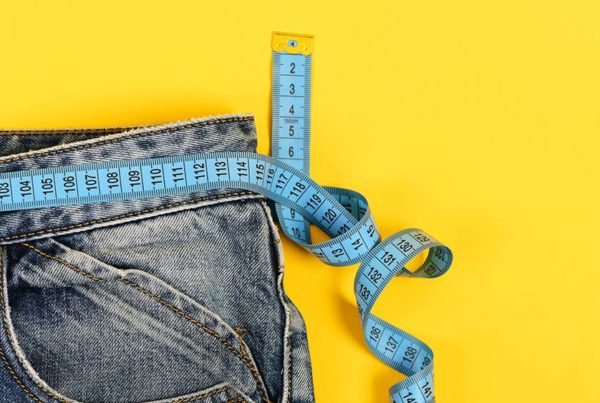
How to address and treat the real cause of excess body fat.
Traditional weight-loss programs have been a spectacular failure, contributing to ill health and ever-increasing rates of obesity and higher body fat. Here’s how you can successfully lose body fat while getting healthier and enjoying delicious food.
It’s been almost four decades since I started helping people get healthier and fit, with weight- and body-fat loss being a key focus. The concept revolves around the idea of fat-burning and maximum aerobic function, or MAF. This simple strategy involves understanding the roles of food and exercise and how these affect your metabolism and energy production. Dispelling the myth of body weight versus body fat, and addressing the actual cause of being overweight — or rather overfat — are also important concepts. While this might seem complicated, it comes down to one important fact: A healthy body is lean, without excess weight or fat. If this is the body you want, read on.
Fat: Not a Four-Letter Word
One thing the world should stop doing is dancing around the body fat issue. Misinformation has led to emotional connections to the problem, including the current trend that excess fat is “in,” OK,” or even “sexy.” The truth is there’s nothing good about too much body fat.
Let’s tell it like it is and refer to body fat in ways it should be addressed — too much is bad for both health and fitness. And when there’s too much let’s just call the problem “overfat.” This term applies to the full spectrum of excess body fat, from modest levels to obesity.
Too much body fat means there are unhealthy conditions affecting the body. This can also affect fitness. An example is that poor metabolism most likely preceded the accumulation of excess fat. And once too much body fat develops, it in turn become a metabolic stress that adversely impairs health. It can become a vicious cycle.
Before discussing the how-to of weight loss, it’s important to provide a reality check because those who understand the game are more successful at it. This involves a brief but important discussion about the dark side of the weight-loss game. It’s possible that you are addicted to certain beliefs that are wrong. Here are two:
- The Calorie Myth. The first is the almighty calorie. The simplistic idea that eating less leads to weight loss is wrong — starvation is not a successful weight-loss approach. If this really worked and was the cause of being overfat we would not have an obesity epidemic that is even affecting babies. Our bodies have a complex metabolism, influenced by our eating habits, and, as discussed later, improving its function by eating well gets the body burning off rather than storing fat.
Instead of counting calories to reduce them, which restricts necessary nutrients, we should be consuming a wide variety of natural foods that improve health. This includes eating high-quality fats, necessary to improve metabolism and burn body fat.
- Scale Confusion. Likewise, we need to let go of the bathroom scale. We step on it each morning, get a number, and feel happy or depressed depending on whether that number is smaller or larger than the previous day. That number is your weight — a misleading, inaccurate, and confusing number. Measuring weight is grossly misleading because it’s largely a measure of water not fat. Because muscle, and its high water content, makes up a significant amount of scale weight, when people become unhealthy enough to lose muscle on low-calorie diets, which is common, the diet appears to be succeeding. However, muscle loss means your metabolism is crashing and you’ll probably pay down the road with more weight and body fat than when you started.
Instead, we should measure body fat since that’s really what we want to lose. The best way to do this is to measure your waist using a flexible tape. This should only be done once weekly as day-to-day changes are too small. Of course, those who lose body fat find their cloths fitting looser, which is also a good guide.
It’s Big, Fat and a Lie
The outrageous claims made by the weight-loss industry complex have been called “the big fat lie,” “the fat trap” and other accurate labels. These sterile, greedy businesses have scammed millions of overfat folks. It’s been such a successful endeavor that people still line up to pay money for products that not only don’t work, but can contribute to ill health.
Yes, it’s a spectacular failure for the hundreds of millions of people, mostly women, who try, over and over, year after year, to lose weight. In the U.S. alone it’s a $20 billion annual cash cow scamming more than 100 million people. Businesses are willing to take your money, more than once, and give you a program that does not work so you come back for more and pay again.
Diet books continue to be the most popular sellers in the publishing industry, and articles with the same lure of weight loss sell magazines (and ads) month after month.
If the world’s popular weight-loss programs were a scientific research project, they would have been abandoned decades ago because of the very high failure rate; not to mention being discontinued for ethical reasons. The results of scientific scrutiny of weight-loss programs are clear: They can make you fat and unhealthy, not to mention costing you a lot of money.
On the other hand, a healthy weight-loss program addresses the primary issue — excess body fat — and the cause of the problem, which is poor health due to eating unnatural foods coupled with reduced fitness.
Here are four common problems associated with people who have too much body fat and are unhealthy:
- Low metabolism. The human body is like an engine, generating energy for all our needs during sleep, daytime movement and exercise. Hormones play a role in this energy generation, including those of the thyroid gland, for example. Poor diet and fitness can reduce thyroid function resulting in too little energy and poor health.
- Poor fat-burning. An important trigger for low metabolism is reduced fat-burning. Normally, we generate significant amounts of energy by burning stored body fat. But when fat-burning is reduced, fat stores rise.
- Muscle loss. Many weight-loss programs lead to muscle loss, which can be misleading. The best disguise that the program is working is when the scale says so. But this, in fact, means you’re headed for yet another disaster. Muscle weighs a lot, like water. So lose a little muscle and it shows on the scale. But fat is burned in muscles, so the more muscle you lose the less you’ll have to burn fat.
- High risk of chronic disease. This include diabetes, cancer, heart disease, Alzheimer’s, stroke, and other preventable conditions. The best way to prevent disease is to maintain healthy levels of body fat.
Here’s how we can reduce body fat: Burn more of it! This is associated with healthy aerobic muscles. Losing more muscle appears to be a good thing, contributing to the confusion about weight loss because the scale makes it seem like a program is working. But this is one reason why people gain weight back, often more than they started with. Lost muscle impairs health and reduces fat-burning. Studies actually show that successful weight-loss programs are associated with more muscle. I have observed thousands of people who have lost significant body fat but little weight — many shrink their waistlines while gaining several pounds on the scale!
More Calorie Confusion
Another problem with the old weight-loss philosophy is the older math: calories in = calories out. Many people believe eating a certain number of calories can be offset by burning calories through exercise, and that if we burn more calories from working out, we’ll lose weight. People even exercise more after a day of bad eating or a holiday weekend where junk food was the main course. This myth continues today. Of course, the problem can best be stated as a question: During exercise, what calories are you burning?
Our bodies burn both sugar and fat for energy, whether at rest (even sleeping), during the day or while working out. Those who have too much stored fat burn more sugar and too little fat at all times. So burning more sugar calories by exercising more won’t help reduce stored body fat. It more often makes you hungry (typically for sweets), and induces metabolic stress. Both can further impair fat-burning and add more stored fat.
The End of Confusion
If all this seems daunting, it is not. It only takes one step to make the change — simply decide to do it right this time. One step, actually, can give you two immediate benefits. First, you get out of the revolving door of the weight loss game. You no longer have to obsess each morning by stepping on the scale, counting calories, going to meetings, and eating miserably — you abandon the old and think of yourself as new. The process involves getting healthy — not just shedding excess body fat, but having significantly more energy and better fitness.
Once you’ve decided to take that first step, there are two important things to do:
Determine how sensitive your metabolism is, especially in relation to insulin sensitivity. Most people with too much body fat are are insulin-resistant. This means two problems occur — they easily convert too much carbohydrate foods into stored body fat, and are prevented from burning high amounts of stored body fat.
Reducing carbohydrate foods and eliminating junk food are the key to stabilizing insulin production. This process is something you can individualize for your particular needs by performing the Two-Week Test.
Improve the function of the aerobic muscles. It’s here that your body burns stored fat for energy. When this happens you become more lean and have much more energy. In addition, a variety of health problems can quickly disappear. Fatigue, hormone imbalance, chronic pain, sleep irregularities, and even more serious conditions such as high blood pressure can change quickly. While muscle-improving exercise is thought to be hard workouts, this actually can worsen metabolism and reduce fat-burning. The best way to do this is using The MAF 180 Formula.
Instead, true aerobic exercise is very easy physically. When you’re finished a workout you should almost feel like you can do the same workout again right away (although that’s not necessary). You should feel energized, not hungry, tired or hurt. For those not regularly working out, a simple 30-minute walk is amazingly effective. If you’re already training for a sport, it means slowing down to improve your fat-burning metabolism (but don’t worry about training slow — you’ll soon get faster at the same heart rate).








